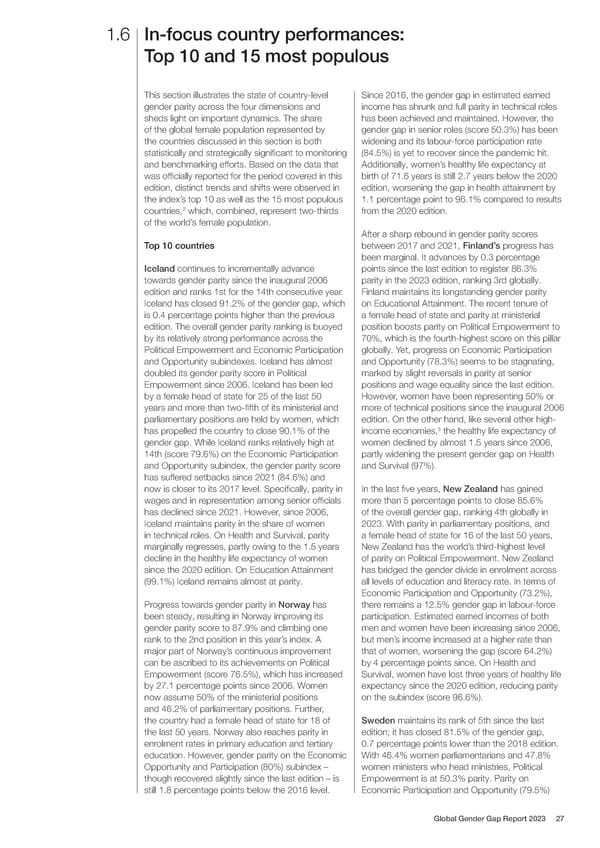1.6 In-focus country performances: Top 10 and 15 most populous This section illustrates the state of country-level Since 2016, the gender gap in estimated earned gender parity across the four dimensions and income has shrunk and full parity in technical roles sheds light on important dynamics. The share has been achieved and maintained. However, the of the global female population represented by gender gap in senior roles (score 50.3%) has been the countries discussed in this section is both widening and its labour-force participation rate statistically and strategically signi昀椀cant to monitoring (84.5%) is yet to recover since the pandemic hit. and benchmarking efforts. Based on the data that Additionally, women’s healthy life expectancy at was of昀椀cially reported for the period covered in this birth of 71.6 years is still 2.7 years below the 2020 edition, distinct trends and shifts were observed in edition, worsening the gap in health attainment by the index’s top 10 as well as the 15 most populous 1.1 percentage point to 96.1% compared to results countries,2 which, combined, represent two-thirds from the 2020 edition. of the world’s female population. After a sharp rebound in gender parity scores Top 10 countries between 2017 and 2021, Finland’s progress has been marginal. It advances by 0.3 percentage Iceland continues to incrementally advance points since the last edition to register 86.3% towards gender parity since the inaugural 2006 parity in the 2023 edition, ranking 3rd globally. edition and ranks 1st for the 14th consecutive year. Finland maintains its longstanding gender parity Iceland has closed 91.2% of the gender gap, which on Educational Attainment. The recent tenure of is 0.4 percentage points higher than the previous a female head of state and parity at ministerial edition. The overall gender parity ranking is buoyed position boosts parity on Political Empowerment to by its relatively strong performance across the 70%, which is the fourth-highest score on this pillar Political Empowerment and Economic Participation globally. Yet, progress on Economic Participation and Opportunity subindexes. Iceland has almost and Opportunity (78.3%) seems to be stagnating, doubled its gender parity score in Political marked by slight reversals in parity at senior Empowerment since 2006. Iceland has been led positions and wage equality since the last edition. by a female head of state for 25 of the last 50 However, women have been representing 50% or years and more than two-昀椀fth of its ministerial and more of technical positions since the inaugural 2006 parliamentary positions are held by women, which edition. On the other hand, like several other high- 3 has propelled the country to close 90.1% of the income economies, the healthy life expectancy of gender gap. While Iceland ranks relatively high at women declined by almost 1.5 years since 2006, 14th (score 79.6%) on the Economic Participation partly widening the present gender gap on Health and Opportunity subindex, the gender parity score and Survival (97%). has suffered setbacks since 2021 (84.6%) and now is closer to its 2017 level. Speci昀椀cally, parity in In the last 昀椀ve years, New Zealand has gained wages and in representation among senior of昀椀cials more than 5 percentage points to close 85.6% has declined since 2021. However, since 2006, of the overall gender gap, ranking 4th globally in Iceland maintains parity in the share of women 2023. With parity in parliamentary positions, and in technical roles. On Health and Survival, parity a female head of state for 16 of the last 50 years, marginally regresses, partly owing to the 1.5 years New Zealand has the world’s third-highest level decline in the healthy life expectancy of women of parity on Political Empowerment. New Zealand since the 2020 edition. On Education Attainment has bridged the gender divide in enrolment across (99.1%) Iceland remains almost at parity. all levels of education and literacy rate. In terms of Economic Participation and Opportunity (73.2%), Progress towards gender parity in Norway has there remains a 12.5% gender gap in labour-force been steady, resulting in Norway improving its participation. Estimated earned incomes of both gender parity score to 87.9% and climbing one men and women have been increasing since 2006, rank to the 2nd position in this year’s index. A but men’s income increased at a higher rate than major part of Norway’s continuous improvement that of women, worsening the gap (score 64.2%) can be ascribed to its achievements on Political by 4 percentage points since. On Health and Empowerment (score 76.5%), which has increased Survival, women have lost three years of healthy life by 27.1 percentage points since 2006. Women expectancy since the 2020 edition, reducing parity now assume 50% of the ministerial positions on the subindex (score 96.6%). and 46.2% of parliamentary positions. Further, the country had a female head of state for 18 of Sweden maintains its rank of 5th since the last the last 50 years. Norway also reaches parity in edition; it has closed 81.5% of the gender gap, enrolment rates in primary education and tertiary 0.7 percentage points lower than the 2018 edition. education. However, gender parity on the Economic With 46.4% women parliamentarians and 47.8% Opportunity and Participation (80%) subindex – women ministers who head ministries, Political though recovered slightly since the last edition – is Empowerment is at 50.3% parity. Parity on still 1.8 percentage points below the 2016 level. Economic Participation and Opportunity (79.5%) Global Gender Gap Report 2023 27
 Global Gender Gap Report 2023 Page 26 Page 28
Global Gender Gap Report 2023 Page 26 Page 28